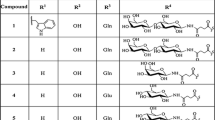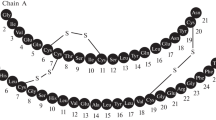Abstract
The purpose of this study was to investigate an efficient synthetic route to the mono-PEGylated growth hormone releasing peptide-2 (GHRP-2) and its biological activity in vivo. The commercially available key PEGylating reagent, mPEG-NHS ester, was successfully utilized to the synthesis of mono-PEGylated GHRP-2, during which the PEGylation profiles of GHRP-2 were monitored by high-performance liquid chromatography (HPLC). The product was purified by cation exchange chromatography, and its biological activity was conducted in rats. The desired mono-PEGylated GHRP-2 as the major product was readily obtained in anhydrous aprotic solvent, such as dimethyl formamide (DMF) and dimethylsulfoxide (DMSO), when the molar ratio of mPEG-NHS ester to GHRP-2 was fixed to be 0.8:1. The products were characterized by matrix-assisted laser desorption ionization time-of-flight (MALDI-TOF) mass spectrometry. The evaluation of the biological activity for the products showed that the mono-PEGylated GHRP-2 gave a more stable activity than GHRP-2, suggesting that PEGylation led to the increase in the half-life of GHRP-2 in plasma without greatly impairing the biological activity. PEGylation of the GHRP-2 is a good choice for the development of the GHRP-2 applications.







Similar content being viewed by others
REFERENCES
Bowers CY. GH releasing peptides: structure and kinetics. J Pediatr Endocrinol. 1993;6:21–31.
Bowers CY, Sartor AO, Reynolds GA, Badger TM. On the actions of the growth hormone-releasing hexapeptide. GHRP Endocrinol. 1991;128:2027–35.
Sawada H. Effect of newly developed analogue of growth hormone releasing peptide [D-Ala-D-beta Nal-Ala-Trp-D-Phe-Lys-NH2 (KP-102)] on growth hormone secretion in adult male rats. Nihon Ika Daigaku Zasshi. 1995;62(2):142–9.
Furuta S, Shimada O, Doi N, Ukai K, Nakagawa T, Watanabe J, et al. General pharmacology of KP-102 (GHRP-2), a potent growth hormone-releasing peptide. Arzneimittelforschung. 2004;54(12):868–80.
Pihoker C, Middleton R, Reynolds GA, Bowers CY, Badger TM. Diagnostic studies with intravenous and intranasal growth hormone-releasing peptide-2 in children of short stature. Clin Endocrinol Metab. 1995;80(10):2987–92.
Peroni CN, Hayashida CY, Nascimento N, Longuini VC, Toledo RA, Bartolini P, et al. Growth hormone response to growth hormone-releasing peptide-2 in growth hormone-deficient little mice. Clinics (Sao Paulo). 2012;67(3):265–72.
Greenwald RB, Choe YH, Mcguire J, Conover CD. Effective drug delivery by PEGylated drug conjugates. Adv Drug Deliv Rev. 2003;55(2):217–50.
Veronese FM, Pasut G. PEGylation, successful approach to drug delivery. Drug Discov Today. 2005;10:1451–8.
Matsushima A, Kodera Y, Hiroto M, Nishimura H, Inada Y. Bioconjugates of proteins and polyethylene glycol: potent tools in biotechnological processes. J Mol Catal B Enzym. 1996;2:1–17.
Pepinsky RB, Lepage DJ, Gill A, Chakraborty A, Vaidyanathan S, Green M, et al. Improved pharmacokinetic properties of a polyethylene glycol-modified form of interferon-b-1a with preserved in vitro bioactivity. J Pharmacol Exp Ther. 2001;297(3):1059–66.
Hooftman G, Herman S, SSchacht E. Poly(ethylene glycols)s with reactive endgroups. II. Practical consideration for the preparation of protein-PEG conjugates. J Bioact Compat Polym. 1996;11:135–59.
Lee LS, Conover CD, Shi C. Prolonged circulating lives of single-chain Fv proteins conjugated with polyethylene glycol: a comparison of conjugation chemistries of conjugation chemistries and compounds. Bioconjugate Chem. 1999;10:973–81.
Grace MJ, Lee S, Bradshaw S. Site of pegylation and polyethylene glycol molecule size attenuate interferon-alpha antiviral and antiproliferative activities through the JAK/STAT signaling pathway. J Biol Chem. 2005;280(8):6327–36.
Esposito P, Barbero L, Caccia P. PEGylation of growth hormone-releasing hormone (GRF) analogues. Adv Drug Deliv Rev. 2003;55:1279–91.
Nojima Y, Iguchi K, Suzuki Y, Sato A. The pH-dependent formation of PEGylated bovine lactoferrin by branched polyethylene glycol (PEG)-N-hydroxysuccinimide (NHS) active esters. Biol Pharm Bull. 2009;32(3):523–6.
Eun JP, Tae HT, Dong HN, Kang CL. Effect of PEGylation on stability of peptide in poly(lactide-co-glycolide) microspheres. Arch Pharm Res. 2010;33(7):1111–6.
Meng ZP, CAO ZP, Wang WS. Synthesizing process of polyethylene glycol mono methyl ether. CN 100586984 C. 2010-2-3.
Author information
Authors and Affiliations
Corresponding author
Rights and permissions
About this article
Cite this article
Hu, X., Xu, B. & Zhou, Z. Synthesis of Mono-PEGylated Growth Hormone Releasing Peptide-2 and Investigation of its Biological Activity. AAPS PharmSciTech 16, 1213–1219 (2015). https://doi.org/10.1208/s12249-015-0307-z
Received:
Accepted:
Published:
Issue Date:
DOI: https://doi.org/10.1208/s12249-015-0307-z




